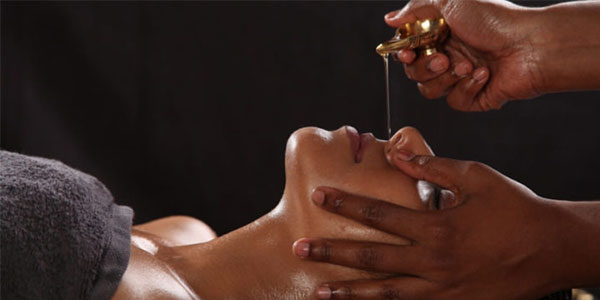
Body massage with medicated oils, treatment for neurological & skin disorders. Abhyanga is a massage that’s done with warm oil. The oil is applied on the entire body, from the scalp to the soles of your feet.
It’s the most popular massage in Ayurveda, a traditional system of medicine from India. Ayurveda focuses on maintaining health through natural practices like massage and what you eat.
Shirodhara is indeed an ancient Ayurvedic healing technique that has been used for centuries to promote relaxation and well-being. However, it's important to clarify some aspects of its purpose and effects.
Shirodhara is primarily a relaxation therapy and is not considered a procedure that "opens up the channels of the brain" to enhance its functionality in the way that modern medical procedures might be used for neurological or psychiatric disorders. Instead, Shirodhara is primarily used for its calming and soothing effects on the mind and body.


Shirodhara is indeed an ancient Ayurvedic healing technique that has been used for centuries to promote relaxation and well-being. However, it's important to clarify some aspects of its purpose and effects.
Shirodhara is primarily a relaxation therapy and is not considered a procedure that "opens up the channels of the brain" to enhance its functionality in the way that modern medical procedures might be used for neurological or psychiatric disorders. Instead, Shirodhara is primarily used for its calming and soothing effects on the mind and body.

Nasya is indeed an Ayurvedic therapeutic procedure that involves instilling medicated drops or oils into the nasal passages. While it has been used traditionally in Ayurveda for various health purposes, including promoting nasal and respiratory health, it is essential to clarify its scope and effectiveness in treating neurological disorders.
Nasya is primarily utilized for conditions related to the head and neck, such as sinus issues, allergies, and certain respiratory problems. It is also believed to have a balancing effect on the doshas (bioenergetic forces) in Ayurveda, particularly on prana vata (a subtype of vata dosha), tarpaka kapha (a subtype of kapha dosha), sadhaka pitta (a subtype of pitta dosha), and majja dhatu (a component of the body tissues).
Kati Basti is indeed a therapeutic procedure used in Ayurveda, a traditional system of medicine that originated in India. It is primarily focused on addressing various musculoskeletal and neurological issues related to the back and spinal cord, including back pain, sciatica, and other related conditions. Kati Basti involves the application of warm medicated oil over the affected area of the back, specifically around the lumbar region, and enclosing it within a ring made of dough or herbal paste.


Kati Basti is indeed a therapeutic procedure used in Ayurveda, a traditional system of medicine that originated in India. It is primarily focused on addressing various musculoskeletal and neurological issues related to the back and spinal cord, including back pain, sciatica, and other related conditions. Kati Basti involves the application of warm medicated oil over the affected area of the back, specifically around the lumbar region, and enclosing it within a ring made of dough or herbal paste.

Janu Basti is another therapeutic procedure used in Ayurveda to address knee joint pain and improve the range of motion in the knee joints. It involves the retention of medicated oil within a specially created reservoir or boundary over the knee joint for a specific duration.
You've provided an accurate summary of the benefits of Janu Basti and Abhyanga in the context of joint health and pain relief:
Janu Basti:
Reduces joint inflammation: The warm medicated oil used in Janu Basti can help reduce inflammation in the knee joint, which is beneficial for conditions like arthritis.
Pain relief: By reducing inflammation and promoting joint health, Janu Basti can provide relief from knee joint pain.
Useful in arthritis: Janu Basti is particularly useful for individuals suffering from arthritis and other painful joint disorders, as it can help manage symptoms and improve joint function.
Abhyanga:
Acts on muscles, ligaments, and skin: Abhyanga is a traditional Ayurvedic massage that directly affects muscles, ligaments, and the skin. It involves the application of warm oil and gentle massage strokes.
Strengthens blood vessels: Abhyanga can strengthen the blood vessels around the knee joint, enhancing their resilience and function.
Nourishes deeper tissues: The nourishing properties of the oil used in Abhyanga penetrate deep into the muscles and ligaments, promoting their health and flexibility.


You've provided an accurate summary of the benefits of Janu Basti and Abhyanga in the context of joint health and pain relief:
Janu Basti:
Reduces joint inflammation: The warm medicated oil used in Janu Basti can help reduce inflammation in the knee joint, which is beneficial for conditions like arthritis.
Pain relief: By reducing inflammation and promoting joint health, Janu Basti can provide relief from knee joint pain.
Useful in arthritis: Janu Basti is particularly useful for individuals suffering from arthritis and other painful joint disorders, as it can help manage symptoms and improve joint function.
Abhyanga:
Acts on muscles, ligaments, and skin: Abhyanga is a traditional Ayurvedic massage that directly affects muscles, ligaments, and the skin. It involves the application of warm oil and gentle massage strokes.
Strengthens blood vessels: Abhyanga can strengthen the blood vessels around the knee joint, enhancing their resilience and function.
Nourishes deeper tissues: The nourishing properties of the oil used in Abhyanga penetrate deep into the muscles and ligaments, promoting their health and flexibility.
